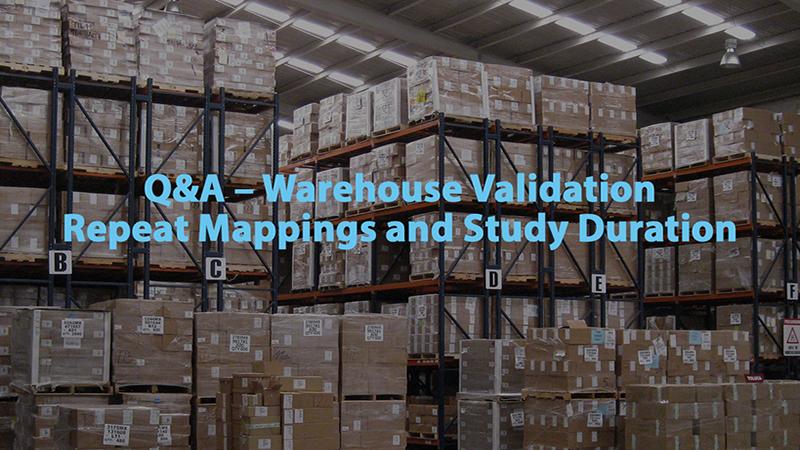Video Q&A: Guidance documents, references, and advice for warehouse mapping
In this video, we answer questions we didn’t have time for during our June webinar “Continuous Mapping in Warehouses: Better Data, Better Compliance.” We invite you to view the recording if you were unable to attend. Today we will focus on questions about re-mapping and study duration. We offer references to guidance documents. Please find links to the references mentioned in the transcript below. If the video below doesn't play, try the direct link. For our next webinar on Part 11/Annex 11 and monitoring systems, scroll down to learn more.
Transcript:
[00:00:50] First question: "What is the proper duration of warehouse mapping and is there any guidance or regulation that tells us how long a mapping should be?"
[00:01:00] Paul: To my knowledge, there is no formal time limit provided by our regulators regarding the duration of any temperature mapping studies, whether we're mapping refrigerators or warehouses. We don't want the mapping to be too short, or we won't catch a representative sample of conditions. And we need to see at least one full operational cycle, which could be defined as a day or a week, depending on the environment. We also don't want that mapping to be too long because we're just wasting time and money to capture data that's just redundant.
I’ve typically used a 72-hour duration for chambers; things like refrigerators, freezers and incubators. I support a 48-hour duration, which is what I recommend to our customers, for chambers. For a warehouse, I recommend a week as the absolute minimum and in some cases two weeks might be appropriate. In our latest webinar [on this topic], we used seven days as our target mapping period for a warehouse.
The easiest reference to support a 7-day warehouse mapping period is from the World Health Organization "Annex 9 - Model guidance for the storage and transport of time- and temperature–sensitive pharmaceutical products”. They say to map warehouses for a minimum of 7to 10 consecutive days. That's for warehouses and other ambient storage areas.
For a chamber, I would refer to the ISPE Good Practice Guide: Controlled Temperature Chamber Mapping & Monitoring. That guide says mapping should be no less than 24 hours. This means 24 hours is the absolute minimum for chamber. The duration should be increased based on a risk analysis for more confidence. That’s why [many] use 72 hours; it’s easier to map for an extra two days than to write up a risk assessment. And you can do a 72-hour mapping over a weekend without losing any weekday time. So: 72 hours for a chamber, seven days for a warehouse.
[00:02:53] Ok great! Note that we have a webinar about performing risk analyses in GxP environments that you can watch at any time. Let's move on to our second question:
“So I understand that I may need to repeat the temperature mapping of my warehouse after major changes or reconfigurations. How much reconfiguration would require a re-mapping?”
[00:03:29] Paul: That's a question that doesn't have an easy answer. As a simple rule of thumb, I think a reconfiguration is only significant enough to consider re-mapping [when it] requires change control. But that's really only a useful distinction if you're quality program is sophisticated enough that you have a change control procedure that covers your warehouse. This would probably be the case for drug manufacturer, but maybe not for a distributor.
So we probably need to dive in just a little more to help you out. If you're moving product, or just storing it in a different part of the warehouse, it probably won't count as a change that needs change control. As long as the new part of the warehouse is monitored and has had a temperature mapping performed. But if I was moving racks, changing their location, their height, or their orientation, this gets into the territory where I would be expecting a change control to evaluate [whether] that change was really serious enough to require re-mapping.
So that's where I would draw the line. If a structure like a warehouse rack needs to be built or unbolted to effect that change, then that reconfiguration needs a change control at a minimum. Part of that change control process is evaluating if a re-mapping is needed. Generally, I say a re-mapping is needed if [the change] affects airflow. Imagine: if we change the orientation of a warehouse rack, you may have effectively created a big wall out of cardboard boxes and pallets. That [wall] will completely change how airflow moves through the space, which will affect how temperature moves through the space. So these are the types of things we need to be thinking about in asking what kind of change will trigger a re-mapping.
Don’t forget that it might not just be physical changes. You want to change the controller set-point on your HVAC system so you can save some energy that probably is going to require a re-mapping.
[00:05:14] Ok, great. Our third question:
“Which guidance tells us when to re-map a warehouse? You said 3 years for warehouses. Why?”
[00:05:25] Paul: If we look back at the ISPE good practice guide mentioned before, the guide for controlled temperature chambers, it says to use a risk assessment to determine re-mapping frequency and to pay attention to local regulatory expectations. That's almost so general that it's not really helpful here. But if we go later in the guide, there's another place where they give us some numbers. They say that a typical GxP practice is to re-map every three to five years, with critical storage getting re-mapped every year.
I interpret things in critical storage to be places like stability chambers. So clearly, we are expected to re-map every year for a warehouse. Three years just seems like a good place to start. Another good guidance comes from the UK, “Good manufacturing practice and good distribution practice”, which says mapping should be repeated every two or three years for a warehouse.
So here's another guidance giving us that three-year mark as a good target for warehouse re-mapping. However, these are just guidances, not regulations. The best the regulations seem to tell us is that qualifications like a warehouse re-mapping should be repeated as necessary. That leads us to decide the frequency [of mapping] based on risk, which includes our knowledge of the system, and the risks associated with the product being stored.
[00:06:43] Ok, great. Thank you. We get a lot of questions from webinar participants asking for guidance or regulations. But it seems that the industry guidance [combined with] actual experience in GxP is what's required for a lot of decision-making.
[00:07:02] Paul: People want to know how often to re-map and discrete advice. But they also want to know what regulation or guidance tells them [how] to do it so that they make sure that they're following the rules. This isn't a bad place to start.
Join us for our next webinar...see below to learn more.


Add new comment